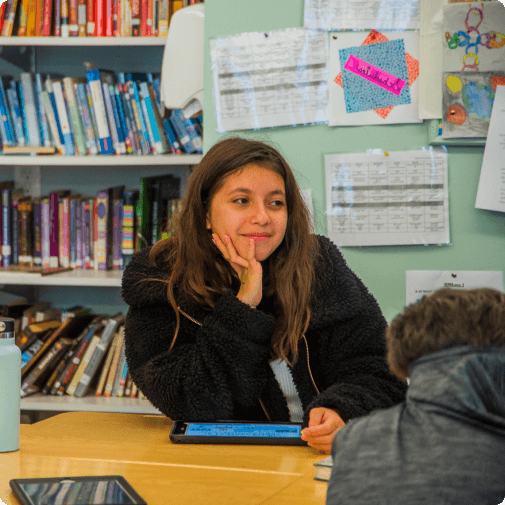GRADES 6-8
Middle School
Middle School is a time of exceptional social, emotional, and cognitive growth. These years mark a profound period of change in the human lifespan.

Our Approach
While physical changes are obvious and well-known, the transformation that happens in the interior life of a middle-schooler is no less dramatic or profound. At All Saints, the approach to teaching and learning, curriculum offerings, and opportunities for student engagement are all designed to meet the myriad needs of young adults at this critical time of growth and development.
In the middle school years, learning how to navigate new social situations, emotional states, and different kinds of relationships is as important as learning how to write an essay. With this in mind, we provide students with a physically and emotionally safe environment that is vital to their healthy development and security for exploration at this age.
Milestone Projects
Grade 5 ~ Brad Ost Memorial Blessing of the Animals
Grade 6 ~ The Turtle Club
Grade 7 ~ Ethics Shadow Boxes
In Seventh Grade, the study of Ethics enables students to develop fellowship among their peers and strengthen their understanding and respect for perspectives other than their own. These key skills are connected to their own sense of spirituality and understanding of how they can make an impact as an individual and as a collective in their community. As part of their Milestone project, students begin by creating a personal code of ethics based on their responses to a series of scenarios and their reading of the book Yummy, by G. Neri. Then, after reading edited excerpts from The Things They Carried, by Tim O’Brien, students create shadow boxes that physically showcase their personal code of ethics as well as the items, events, and moments that have shaped them into the people they are today. They share these shadow boxes with classmates and their families in a culminating event near the end of the school year.
Grade 8 ~ Community Project
Throughout the year, students in Grade 8 experience the themes of the school’s mission statement as they relate to the greater community and the world community. As a culmination of their time at All Saints and as a requirement for the International Baccalaureate Middle Years Programme, students complete a year-long Community Project related to the mission of the school. Examples of past projects include:
- designing and selling stickers to raise money for service projects in Ecuador
- volunteering in the after school program
- assisting with technology management
- coordinating games for elementary students during lunch and recess
- developing clubs and enrichment opportunities for younger students
An Overview of our Middle School Curriculum
Grade 5
In Fifth Grade, teachers work to transition students into middle school. Students are excited to get their own lockers, to have their classes in the various Middle School rooms, to use their iPads for more academic tasks, and to move independently throughout the building for classes. The key themes that are stressed during this important transition into Middle School are personal responsibility, time management, and self-control. As Fifth Graders embark on their Middle School journey, they soon discover how to keep their locker and binders organized, how to stay on track with various homework assignments and projects assigned by their teachers, and how to participate in lively class discussions and activities in a mature manner.
Language and Literature in the Fifth Grade serves to enrich the Individuals & Societies and Essential Questions curriculums, while developing vital grammar, writing and editing skills necessary for success throughout middle school, high school, college and beyond. Going beyond basic comprehension, class discussions reach toward a deeper understanding of the characters and plot, as well as the author’s intent and writing techniques. Students are asked to write about the literature, developing essay skills, persuasive and expository writing skills, in addition to creative and technical writing mechanics. Spelling and vocabulary are also addressed through reading and writing assignments. Throughout the year, students also focus on typing projects using the basic guidelines for MLA formatting.
Individuals and Societies begins with a study of man’s prehistoric beginnings, explores the Neolithic Revolution, and analyzes the development of several ancient civilizations. The curriculum uses both a textbook and literature chosen to bring this era to life. Readings, discussions and activities focus on geography, society, religion, art and architecture, achievements and government. Students develop critical and creative thinking skills by connecting ancient history to today’s world through a variety of projects and writing assignments.
The core of Fifth Grade Math is to develop greater efficiency with all four operations including basic facts, regrouping, and mental math, while working with whole numbers, decimals, and fractions. Students also delve deeper into geometry, measurement, graphing, and probability, and learn to describe and explain mathematical concepts in class discussions and in writing. The common Fifth Grade question, “Is this right?” is often met with, “Explain why you think it’s right.” Students learn to look more at the process and algorithms rather than just the answer.
Fifth Grade covers concepts in Physical, Life and Earth Science which follow the NGSS (Next Generation Science Standards). Units include Gravity and the Four Spheres, Solar System Patterns and Star Brightness, Plant and Abiotic Resources, Matter Movement Among Organisms and the Environment, Visualizing Matter and Compounds, and Theories of Matter. Each unit includes opportunities to explore concepts in greater depth through labs and investigations. Field trips allow students to explore concepts in real-life settings.
Grade 5 Students partake in several co-curricular activities such as music, art, physical education, and world language. Please see our Beyond Core Academics page.
Grade 6
By Sixth Grade, students have firmly established themselves in the Middle School and are ready for new challenges. Throughout Sixth Grade, the students focus on individuals who have overcome hardships and the different challenges faced at different stages in life. A favorite Sixth grade activity is interviewing “Turtles,” those who have shown courage and perseverance in the face of great challenges, much like sea turtles. As the students continue to mature and grow in their abstract thought, they begin to experience new activities and ideas on a daily basis.
Language and Literature in the Sixth Grade utilizes a variety of writing and grammar projects. Students read and discuss novels that correlate with the Individuals & Societies and Essential Questions curriculum. Students continue with their grammar and vocabulary studies. At this grade level, students build on their base knowledge and also begin to learn to cite sources using MLA formatting.
- The Sixth Grade Individuals and Societies curriculum encompasses a wide array of world cultures and tracks their development from the Dark Ages through the Modern Era. Beginning with the rise of the Byzantine and Islamic civilizations and extending through the Middle Ages, Renaissance, Enlightenment and the Industrial Revolution, students explore the historical, economic, political and cultural achievements of early societies inhabiting Europe, Asia, and the Americas. The curriculum utilizes a textbook and integrates rich literature that supports intelligent discussions and meaningful connections to the time periods and cultures studied. A variety of non-fiction and fiction texts are incorporated into the curriculum.
Sixth Grade Math builds on the independence gained in Fifth Grade as students continue to develop their facility with basic operations involving whole numbers, fractions and decimals, and are introduced to complex systems of mathematics like algebra and geometry. Students develop a fuller understanding of factors and divisibility. They continue to explore forms of measurements, both U.S. customary and metric in the areas of weight, length, temperature, and capacity, while extending their skills to include conversions. As they pursue algebra, they investigate integer operations and algebraic expressions.
Sixth Grade covers concepts in Life, Physical, and Earth & Space Science which follow the NGSS (Next Generation Science Standards). Topics of study include Ecology, Classification of Plants and Animals, Cell Structures, Environmental Issues, Temperature and Thermal Energy Transfer, Gravity, Earth’s History and the Formation of the Solar System, and Seasons and Lunar Phases. Students create models and complete labs and demonstrations to expand their learning. Field trips also provide opportunities for students to see the real-life application of concepts.
Grade 6 Students partake in several co-curricular activities such as music, art, physical education, and world language. Please see our Beyond Core Academics page.
Grade 7
Seventh Grade students are ready for more challenges and have many opportunities to learn and grow from the community. The year is marked by many exciting milestone projects, such as their community service experiences in local organizations. Seventh Grade students are granted more leadership opportunities in our campus life and community projects. The level of guidance given on projects and assignments decreases as students grow in their independence, organization, and cognitive abilities. Giving them space and direction to become responsible citizens is pivotal at this age as students begin the transition from childhood into adulthood.
Language and Literature in the Seventh Grade is packed with an exciting variety of topics and projects. Students read and discuss novels that correlate with their Individuals & Societies and Design curriculum. At this grade level, students are expected to submit all work in MLA format with correct citations. Additionally, students learn how to quote both text and dialogue using MLA formatting.
- The Seventh Grade Individuals and Societies curriculum focuses on America and the formation of the United States. Students begin their study with an examination of Native American history and societies, moving through the arrival of Europeans up to the end of the Civil War. Students examine the development of American geography, economics, politics and culture, focusing on the impact of decisions on many groups, from the indigenous people of the Americas to enslaved people to women. The curriculum utilizes the core text A Young People’s History of the United States in addition to carefully selected rich literature that provides a platform for intelligent discussions and meaningful connections to this time period.
Seventh Grade Math continues to explore complex systems of mathematics such as algebra and geometry. Students develop a broad understanding of exponents, roots & scientific notation. They begin to examine geometric theorems and the balancing and graphing of algebraic equations. Students become familiar with coefficients and formulas. Throughout these new explorations, they will continue to improve their facility in working with integers, decimals, fractions, and percents. An advanced section, a pre-algebra course, offers more independent problem solving explorations and skill development, as well as an additional unit of data analysis, and further exploration of functions and graphing to help prepare them for algebra in Eighth Grade. Projects can differ from year to year, depending on current events, but have included topics such as risk analysis for hurricane and tornado prone areas or creating a newspaper to showcase the use of percentages in real-world situations. Grade 7 Math also includes a personal finance course with lessons centered on money management, wise consumerism and career exploration. Topics include savings, investing, and risk management, taxes, salary, net monthly income calculation and creation of an effective household budget.
Seventh Grade covers concepts in Physical, Life, and Earth & Space Science which follow the NGSS (Next Generation Science Standards). Units of study include Energy, Waves, Electromagnetism, Cellular Processes, Photosynthesis, Genetics, Human Body Systems, Thermal Energy, and Renewable Resources. Students not only learn about the scientific concepts but connect them to issues of equity in the world. They create models, engage in experiments, and view demonstrations to support their learning. Field trips further enhance their experience by providing real-world examples of scientific concepts.
Grade 7 Students partake in several co-curricular activities such as music, Latin, art, physical education, and world language. Please see our Beyond Core Academics page.
Grade 8
Eighth Grade is an action-packed and productive year at All Saints. Students start the year with a bang, getting right down to the important work of producing graded writing samples to be used as part of their application to high school. Students’ work continues to grow in length and depth, but mostly in the independence they are given to develop their ideas and organize their thoughts. A highlight for the year is a capstone field trip, where students engage in mission-focused experiences to celebrate their years at All Saints. Of course, the end of the year is bittersweet for all, as students celebrate the end of their Middle School years through the planning and execution of their graduation ceremony and celebration. Throughout the year, students prepare for this important ceremony by reflecting on their time at All Saints and how they will continue to live the School’s mission statement.
In the final year of their Middle School journey, students intensify their studies in Language and Literature as they prepare for high school. Students read a variety of novels that relate to their Individuals & Societies and Rites of Passage classes. Projects focus on writing across a variety of genres, including analytic essays, research papers, poetry, news articles, and speeches. Their major project is an analysis of a modern-day human rights violation in conjunction with the study of the Universal Declaration of Human Rights in Individuals & Societies. Students study and follow the MLA style requirements to write expository papers in preparation for high school-level work and continue their vocabulary and grammar studies.
The Eighth Grade Individuals and Societies curriculum begins where the Seventh Grade study of American history ends. This survey of American history spans from the end of the Civil War and Reconstruction to the modern era. The curriculum uses a core text as well as carefully selected rich literature that is the impetus for high-level classroom discussions and powerful connections to this time period. Additionally, Eighth Grade students examine the global influence of the U.S. in a geographic, political and economic context throughout the 20th and 21st centuries. Students examine and analyze historical and present day political maps, identifying areas of U.S. influence throughout the world.
Eighth Grade Math continues to explore complex systems of mathematics like algebra and geometry. Students develop a fuller understanding of coefficients, formulas & positive and negative scientific notation. They begin to examine direct variation, inequalities with negative and positive coefficients, slope, and various forms of linear equations. Throughout these new explorations, they continue to improve their facility in working with decimals, fractions, percents, and exponents. For those in the advanced section, an Algebra course, the curriculum covers additional topics in algebra such as adding radical expressions, defining and graphing sequences, function notation, systems of equations, exponential functions, and various methods for solving quadratic functions. Eighth Grade students also explore the history of mathematics as a tool for understanding nature.
- Eighth Grade covers concepts in Life, Earth & Space, and Physical Science which follow the NGSS (Next Generation Science Standards). Topics of study include Evolution and Adaptation, Weather, Climate, the Human Impact on the Earth, Energy, the Electromagnetic Spectrum, Circuits, and Forces and Motion. Students use the practices of analyzing and interpreting data, developing and using models, and engaging in arguments from evidence to make sense of these topics. Projects, labs, and demonstrations further enhance the curriculum, as students are expected to engage in increasingly sophisticated demonstrations of their knowledge, such as building a circuit and designing an environmentally-friendly tiny house in conjunction with their Design studies.
Grade 8 Students partake in several co-curricular activities such as music, Latin, art, physical education, and world language. Please see our Beyond Core Academics page.

“The integrity of an All Saints education was proven over the course of the prolonged pandemic – it was a thrill to see the IB Learner Profile Traits in action. Our students demonstrated resilience, adaptability and creativity in the ever-shifting academic landscape.”
Amanda Dillon, Upper School Division Head

Life After All Saints
The final leg in the All Saints journey includes family participation in our comprehensive high school placement program, which results in our students going on to study at an impressive array of prestigious day and boarding high schools in the metropolitan region and beyond.
We'd Love to Hear from You:
LOCATIONS
707 Washington Street, Hoboken, NJ, 07030
527 Clinton St, Hoboken, NJ 07030
CONTACT







